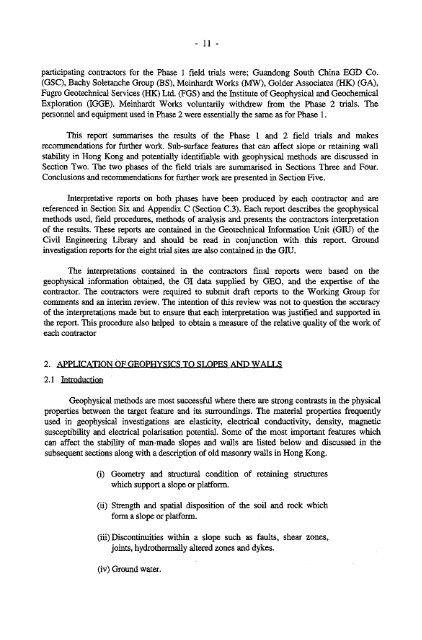site characterisation study - phases 1 and 2 - HKU Libraries - The ...
site characterisation study - phases 1 and 2 - HKU Libraries - The ...
site characterisation study - phases 1 and 2 - HKU Libraries - The ...
- No tags were found...
Create successful ePaper yourself
Turn your PDF publications into a flip-book with our unique Google optimized e-Paper software.
- 11 -participating contractors for the Phase 1 field trials were; Gu<strong>and</strong>ong South China EGD Co.(GSC), Bachy Soletanche Group (BS), Meinhardt Works (MW), Colder Associates (HK) (GA),Fugro Geotechnical Services (HK) Ltd. (FGS) <strong>and</strong> the Institute of Geophysical <strong>and</strong> GeochemicalExploration (IGGE). Meinhardt Works voluntarily withdrew from the Phase 2 trials. <strong>The</strong>personnel <strong>and</strong> equipment used in Phase 2 were essentially the same as for Phase 1.This report summarises the results of the Phase 1 <strong>and</strong> 2 field trials <strong>and</strong> makesrecommendations for further work. Sub-surface features that can affect slope or retaining wallstability in Hong Kong <strong>and</strong> potentially identifiable with geophysical methods are discussed inSection Two. <strong>The</strong> two <strong>phases</strong> of the field trials are summarised in Sections Three <strong>and</strong> Four.Conclusions <strong>and</strong> recommendations for further work are presented in Section Five.Interpretative reports on both <strong>phases</strong> have been produced by each contractor <strong>and</strong> arereferenced in Section Six <strong>and</strong> Appendix C (Section C.3). Each report describes the geophysicalmethods used, field procedures, methods of analysis <strong>and</strong> presents the contractors interpretationof the results. <strong>The</strong>se reports are contained in the Geotechnical Information Unit (GIU) of theCivil Engineering Library <strong>and</strong> should be read in conjunction with this report. Groundinvestigation reports for the eight trial <strong>site</strong>s are also contained in the GIU.<strong>The</strong> interpretations contained in the contractors final reports were based on thegeophysical information obtained, the GI data supplied by GEO, <strong>and</strong> the expertise of thecontractor. <strong>The</strong> contractors were required to submit draft reports to the Working Group forcomments <strong>and</strong> an interim review. <strong>The</strong> intention of this review was not to question the accuracyof the interpretations made but to ensure that each interpretation was justified <strong>and</strong> supported inthe report. This procedure also helped to obtain a measure of the relative quality of the work ofeach contractor2. APPLICATION OF GEOPHYSICS TO SLOPES AND WALLS2.1 IntroductionGeophysical methods are most successful where there are strong contrasts in the physicalproperties between the target feature <strong>and</strong> its surroundings. <strong>The</strong> material properties frequentlyused in geophysical investigations are elasticity, electrical conductivity, density, magneticsusceptibility <strong>and</strong> electrical polarisation potential. Some of the most important features whichcan affect the stability of man-made slopes <strong>and</strong> walls are listed below <strong>and</strong> discussed in thesubsequent sections along with a description of old masonry walls in Hong Kong.(i) Geometry <strong>and</strong> structural condition of retaining structureswhich support a slope or platform.(ii) Strength <strong>and</strong> spatial disposition of the soil <strong>and</strong> rock whichform a slope or platform.(iii) Discontinuities within a slope such as faults, shear zones,joints, hydrothermally altered zones <strong>and</strong> dykes.(iv) Ground water.
















